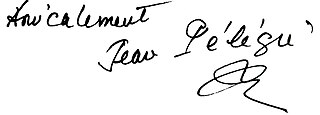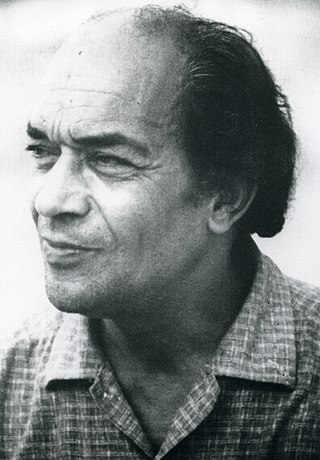Related Research Articles

Tlemcen is the second-largest city in northwestern Algeria after Oran and is the capital of Tlemcen Province. The city has developed leather, carpet, and textile industries, which it exports through the port of Rachgoun. It had a population of 140,158, as of the 2008 census.

Mohammed Dib was an Algerian author. He wrote over 30 novels, as well as numerous short stories, poems, and children's literature in the French language. His work covers the breadth of 19th century Algerian history, focusing on Algeria's fight for independence.

Jean Pélégri was a writer and professor of literature. Of French descent, he was born in Algeria, but left as part of the diaspora of French colonists referred to as pieds-noirs following the Algerian War.

Gharnati refers to an Algerian variety of Andalusian classical music originating in Tlemcen. Its name is derived from the Arabic name of the city of Granada. Gharnati has also become an established tradition in other cities in western Algeria, such as Oran and Sidi-Bel-Abbès. In the 20th century it also spread to Morocco after being brought over by Algerian families who moved there fleeing French colonial rule in Algeria, and eventually founding conservatories in cities like Oujda and Rabat.

Algerian literature has been influenced by many cultures, including the ancient Romans, Arabs, French, Spanish, and Berbers. The dominant languages in Algerian literature are French and Arabic.

Baya Bouzar, known by the stage name Biyouna (بيونة), is an Algerian singer, dancer, and actress born in Belcourt, now known as Belouizdad, Algiers, Algeria.
The Last Image is a 1986 Algerian drama film directed by Mohammed Lakhdar-Hamina. It was entered into the 1986 Cannes Film Festival. The film was selected as the Algerian entry for the Best Foreign Language Film at the 59th Academy Awards, but was not accepted as a nominee.

Mohammed Khadda was an Algerian painter, sculptor, and writer. Khadda has been considered to be among the founders of contemporary Algerian painting and one of the many representatives of the "sign painters.", as indicated by his nickname "peintre du signe" given by Jean Sénac. He debuted in 1960. His influences included Cubism and Arabic calligraphy. He tended toward the non-figurative or abstract. He represented a generation of Algerian artists who combined the ideas of calligraphic heritage and formal language of Western formal writing through Western abstraction through the 1950s.

Amin Zaoui is an Algerian novelist. He was born in Bab el Assa in Tlemcen province and studied at the University of Oran, obtaining a PhD in comparative literature. He moved to France during the Algerian civil war, but returned home in 1999. He has served as the Director General of the National Library of Algeria, and currently teaches comparative literature at the Central Algerian University.

Fatma Zohra Zamoum is a Franco-Algerian writer, filmmaker and educator.
Slimane Bengui was an Algerian writer and businessman. He was the director of the first French-language Algerian newspaper "El Hack". Moreover, he was also a tobacco manufacturer.
The Campaign of Tlemcen or Tlemcen campaign was a military operation led by the Saadians of Mohammed ash-Sheikh against Tlemcen in 1557, then under the domination of the Regency of Algiers, a vassal state of the Ottoman Empire. Mohammed ash-Sheikh, who wanted to conquer Algeria, occupied the city but failed to seize the Mechouar Palace, which was defended by a garrison of 500 men under the command of Caïd Saffa.

In Algeria, the Islamic festival of Ashura, on 10 Muharram, is a public holiday, traditionally marked by celebration, zakat-giving, fasting, and cemetery visits depending on the region. In some areas the celebration incorporates dances, music, and masquerades.

The Campaign of Tlemcen (1551) was a military operation led by the Regency of Algiers under Hasan Pasha and his ally Abdelaziz, following the capture of Tlemcen by the Saadi Sultanate in June 1550.

Spanish Oran was a territory of the Spanish Empire as a result of the Conquest of Oran.
Ahmed bin Ali Khodja, also known as Ahmed II was the Dey (Sultan) of Algiers between 1805 and 1808. He came to power after assassinating the previous Dey, Mustapha II and his close friend and associate, Boudjenah with the help of the janissaries of the Odjak of Algiers. The fall of Mustapha, and Ahmed's coming to power resulted in the Odjak's influence severely overinflating and severe instability for the next 10 years. Corruption became rampant in the country, and the Odjak became a sort of ruthless kingmaker council, and forced Ahmed and the next few upcoming Deys to bow to any will they had. Just in the first 30 days of his rule, he looted the property of the Jewish residents of Algiers, and committed several and massacres. His rule was marked with many revolts, from Kabyle tribes, Arab tribes, Darqawiyya Sufis, and even the population of Tlemcen. His unpopularity rapidly increased after sustaining a severe defeat in 1807 by the Tunisians resulting in Tunis losing any sort of Algerian influence, and despite his best efforts to make them happy, the Odjak of Algiers decided to remove him and kill him in 1808 in favor of Ali ben Mohammed, a leader in the Odjak.
The Fire (L'Incendie) is a novel by Mohammed Dib, published in 1954.
References
- ↑ "La Grande Maison | work by Dib | Britannica". www.britannica.com. Retrieved 2024-04-03.
- ↑ Amhis-Ouksel, Djoher (2006). Dar sbitar: une lecture de la Grande maison de Mohammed Dib (in French). Casbah éditions. ISBN 978-9961-64-556-7.
- ↑ MOHELLEBI, Aomar (9 May 2022). "Le petit Omar de la «Grande Maison»". lexpressiondz.com.
- ↑ "La grande maison Mohammed Dib". critiqueslibres.com (in French). Retrieved 2024-04-03.
- ↑ Still, Edward John (2019-01-14). Representing Algerian Women: Kateb, Dib, Feraoun, Mammeri, Djebar. Walter de Gruyter GmbH & Co KG. ISBN 978-3-11-058610-7.
- ↑ Woodhull, Winifred (2000). "Mohammed Dib and the French Question". Yale French Studies (98): 66–78. doi:10.2307/2903228. ISSN 0044-0078. JSTOR 2903228.
- ↑ "In pictures: Impressions of a lost world in pre-independence Algeria". Middle East Eye. Retrieved 2024-04-03.